Explore the diverse types of yachts with our comprehensive guide. Learn about various designs, construction materials, hull and keel configurations, rigging options, and specific yacht categories like day sailers, trailer yachts, sports boats, cruising yachts, and multihulls. Perfect for boating enthusiasts and prospective yacht owners.
- Design
- Construction types
- Fibre-reinforced plastic
- Wooden
- Aluminium or steel
- Ferro-cement
- Hull/keel configurations
- Rigs
- Trailer/sailer
- Day sailer
- Trailer yacht
- Towing
- Sports boats
- Second-hand yachts
- Pocket cruiser racing yachts
- Mid-sized cruising yachts 27-50 ft (8,3-15,2 m)
- Multihulls
- Trimarans
- Motor sailers
Almost certainly, the right boat is out there waiting for you. Selecting her will involve emotional and practical considerations. I yearn to own a Morgan sports car but also need a vehicle to carry young grandchildren, as well as a tool chest, down to the boat yard during winter months, and to be able to throw a lawnmower in the back. A two-seater cannot cope with any of that. Buying a yacht requires the same practical thought processes.
Design
Racing, they say, improves the breed, and this is certainly the case with yacht design, which in five decades, has progressed from traditional narrow, heavy displacement hulls with integral keel and rudder profiles to much more efficient wide beam, light displacement forms with all manner of keel and rudder configurations.
The greater volume within modern designs, developed to increase form stability and improve performance off the wind, has the practical benefit for cruising in providing more volume below, allowing for bigger berths, a fully fitted galley and heads (toilet), even in the most modestly sized yachts.
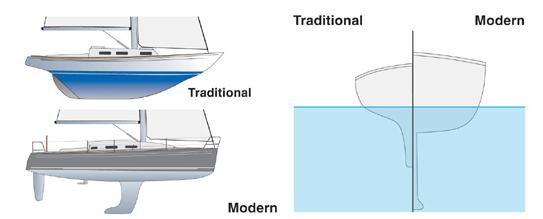
There has been a marked change in hull profiles too. The graceful raked bows that mark out yachts from the 1950s to 1980s have given way to plumb bows and sterns, drawn to extend waterline length and thus speed and, as a by-product, extend internal volume.
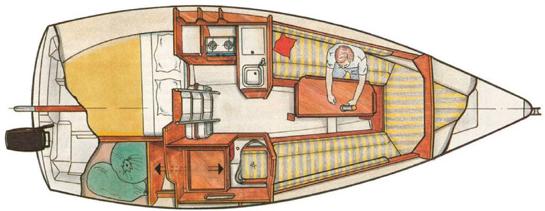
There is a financial advantage too, for by minimising bow and stern overhangs, berthing fees are proportionally less.
Construction types
Fibre-reinforced plastic
Fibre-reinforced plastic yachts are by far the most popular, being lighter and Operation and Maintenance of the Your Own Sailboatrelatively low maintenance. They are long lasting and hold their value well. Indeed, many of the early GRP yachts built during the 1960s are still going strong and commanding good prices in the brokerage columns. Later models are often moulded using more exotic materials to the simple chopped strand glass mat and incorporate Kevlar and even carbon fibre to provide greater strength without increasing overall weight.
When purchasing second hand, look for stress cracks around the shroud plates, mast slot and corners within the moulding. Star crazing within the gel coat around the hull and deck is a clue to minor impact damage.
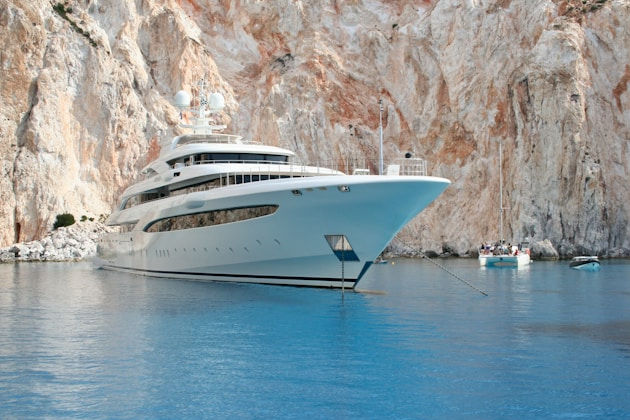
Source: unsplash.com
Check also for signs of osmosis. This water penetration through the outer gel coat manifests itself as small blisters below the waterline. This is expensive to repair, requiring the gel coat to be planed off, the hull dried, and the affected areas re-coated with an epoxy-based resin.
Wooden
Wooden yachts have more character but require more work. If you don’t enjoy maintenance as much as sailing, steer clear of these.
If you are certain about buying a classic, then a survey is essential. Rot is the most prevalent enemy and will manifest itself anywhere where rain water gets trapped and soaks into the wood.
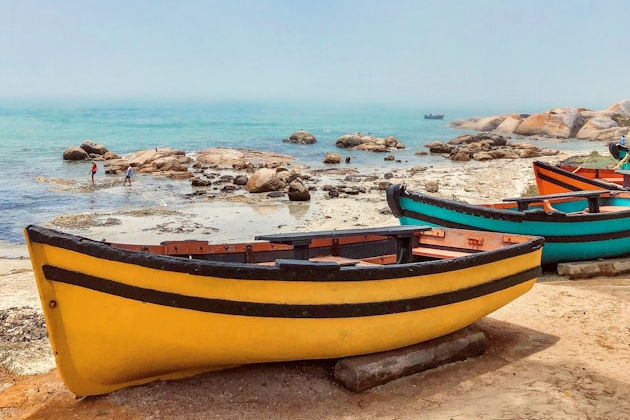
Source: unsplash.com
Vessels moored in salt water fare much better than those kept on a lake or river, but marinas, even those opening on to the sea, are often fed by fresh water streams which results in a brackish water environment, and is no kinder to wood than fresh water.
Wood, Aluminum and John BoatsWooden boats require regular maintenance to keep on top of a deteriorating atmosphere; wood should never be allowed to peel or go bare, and requires annual painting. Wooden boats are a labour of love. Be sure they are for you before you invest.
Aluminium or steel
Metal fabricated hulls are strong but require regular painting to minimise corrosion. They can also suffer from condensation in winter months unless they are well insulated. When buying second-hand, a survey is imperative.
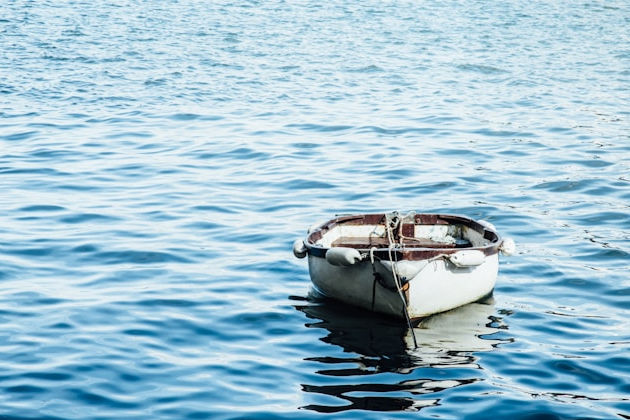
Source: unsplash.com
Check in particular for signs of electrolytic corrosion between hull plating and bronze fittings and stern gear.
Ferro-cement
Ferro-cement yachts are often amateur constructed. They are, however, relatively easy to construct by plastering concrete over a wire frame and, providing the wire remains encased, and not allowed to rust, these hulls can be very durable.
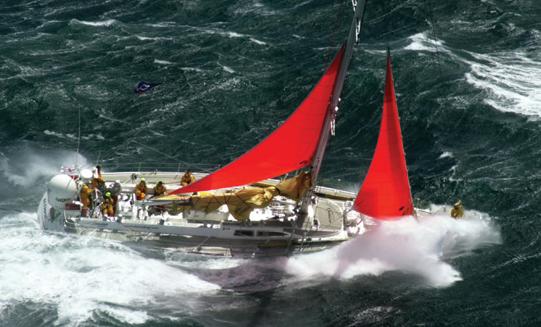
They have a low second-hand value.
Hull/keel configurations
| Full-length keel with stern-hung rudder | ||
|---|---|---|
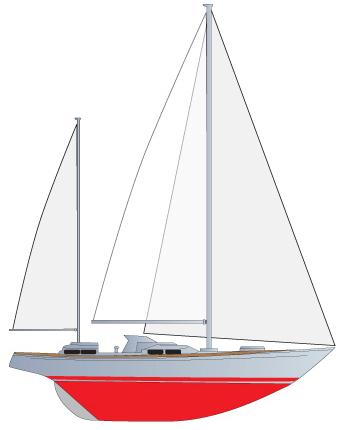 | Era | Pre 1970s |
| Pros | Good directional stability. Excellent sea keeping qualities | |
| Cons | Narrow beam, minimising accommodation. Unpredictable when steering astern | |
| Twin bilge keels with skeg-hung rudder | ||
|---|---|---|
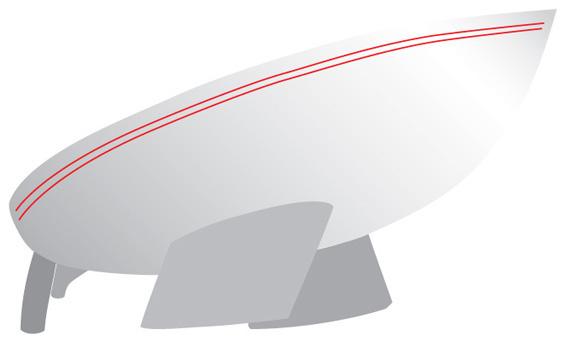 | Era | Post mid-1960s |
| Pros | Allows yacht to be beached, even on stony ground. Particularly suitable where moorings dry out at low tide. If you run aground, the boat stays upright. Also, when laying up over the winter, the boat does not need a cradle | |
| Cons | Not as efficient as a fin keeled configuration when sailing upwind. Their offset position can also create weather helm when the yacht is over-pressed | |
| The purpose of the twin bilge keel concept is to provide a tripod of “feet” so the yacht stands upright when taking to the ground | ||
| Separate fin and skeg-hung rudder | ||
|---|---|---|
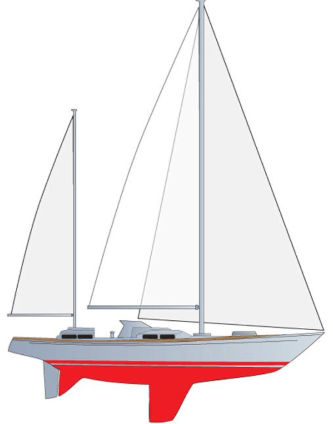 | Era | Post 1970s |
| Pros | Less wetted area than full-length keel and more predictable when steering astern. Excellent sea-keeping qualities | |
| Cons | Narrow beam though 1980s era saw beam width increasing | |
| Shoal keel | ||
|---|---|---|
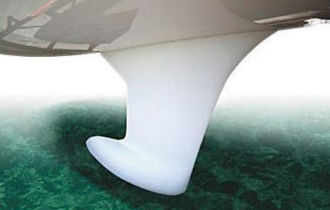 | Era | Post 1980s – A shallow fin keel often with a bulb on the bottom to provide a similar righting moment to the deeper fin keel |
| Pros | Shallow draft suitable for use in rivers and estuaries | |
| Cons | Less efficient than a standard fin keel, offering less lateral resistance upwind | |
| Drop keel | ||
|---|---|---|
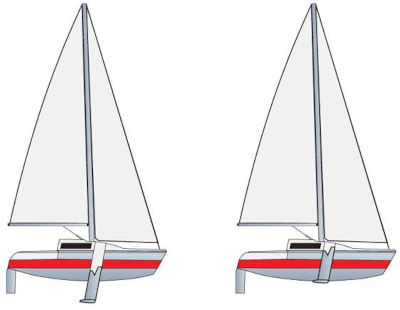 | Era | Post 1960s – Acts like a daggerboard inside vertical trunking with a winch or block and tackle to raise the keel. In the event of a knockdown, a locking mechanism keeps the keel from sliding back up its casing |
| Pros | The trunk is much narrower than with a swing keel and its “stiletto” shape, which often includes a bulb on the bottom, is more efficient | |
| Cons | If you run aground, this puts a great deal of stress on the trunking. The trunking also acts as a huge cabin divider. When the keel is raised, then so too is the centre of gravity and the boat becomes more tippy | |
| Wing keel | ||
|---|---|---|
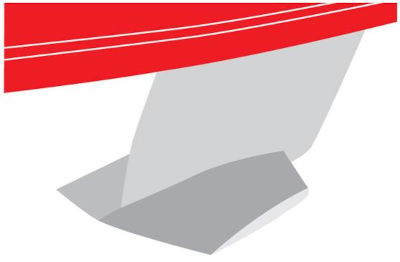 | Era | Post mid-1980s – A fin keel with winglets on the tip to provide an end-plate effect to maintain water flow around the lower section of the foil |
| Pros | More efficient than a fin keel. The wing also adds weight to the bottom of the keel and extends the depth of the foil when the yacht is heeled over | |
| Cons | If you run aground, the wing is more susceptible to damage and getting stuck in mud | |
| Asymmetric daggerboards | ||
|---|---|---|
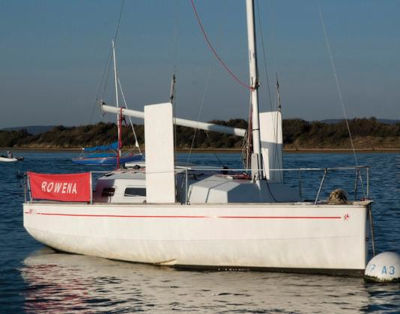 | Era | Post 1990s – This is where the trunking is offset from the centreline |
| Pros | This offers the same shallow draft benefits of the swing keel, without the trunking taking up space in the middle of the cabin. Instead, the trunking for the lifting daggerboards form part of the side berths and remain unobtrusive | |
| Cons | Two keels to worry about rather than one | |
| Swing keel | ||
|---|---|---|
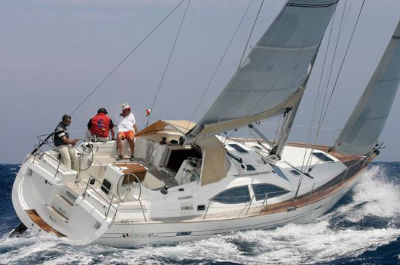 | Era | Post 1970s. A heavier version of the sheet metal centre plate used in early dinghies and day boats. Now available in much larger shoal draft cruising yachts |
| Pros | Provides a similar performance to a fin keel while providing the ability to beach the yacht. If you accidently run aground, you simply crank up the keel and sail away. Some swing keel designs like those fitted in the Southerly range, have a cast iron grounding plate which serves as fixed ballast and protects the bottom when drying out. Jeanneau (opposite) house their swing keel within a stub keel and the yacht is supported by this and her twin rudders when taking the ground | |
| Cons | Early designs used a steel pin to lock the keel in its “down” position. If you ran aground, this could become bent and difficult to remove | |
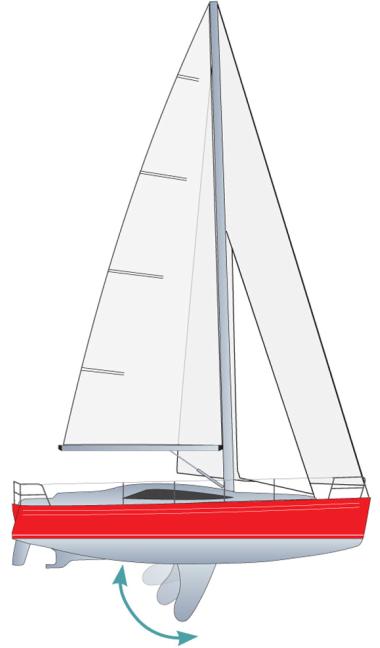



Rigs
Bermudan masthead sloop
Most common cruising rig with triangular mainsail and full height overlapping genoa.
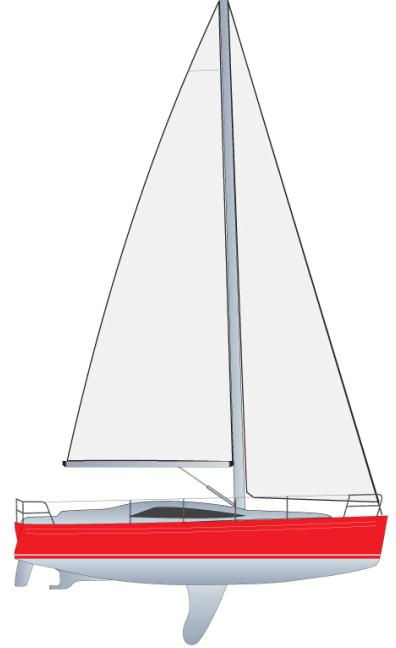
Fractional rig
Modern alternative to the masthead rig.
Pros: The smaller jib makes for easier sail handling. The mainsail is often fully battened and relies on a simple slab reefing system to lessen area.
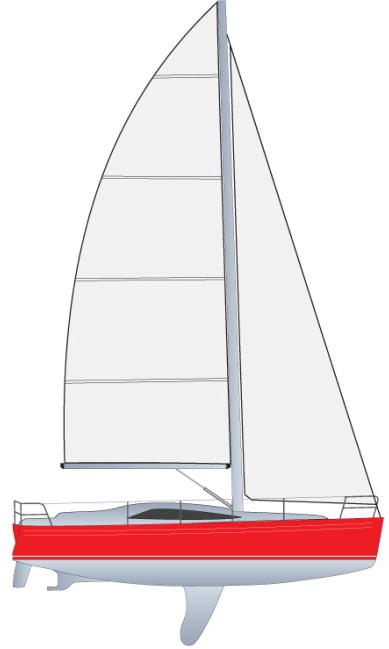
Cons: Long boom can drag in water when overpressed making it difficult to spill wind.
Cutter rig
Similar to the masthead rig but with a staysail set as an intermediate sail between the genoa and mainsail.
Pros: More efficient than the standard sloop when sailing just off the wind.
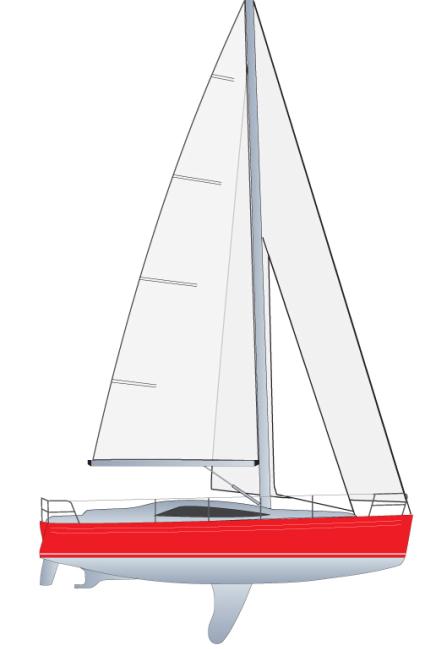
Cons: Not as close-winded as the sloop rig.
Gaff rig
Traditional sail plan with a quadrilateral mainsail supported at the top by a gaff spar.
Pros: Simple to hoist and reef, and has a lower centre of pressure than a sloop rig.
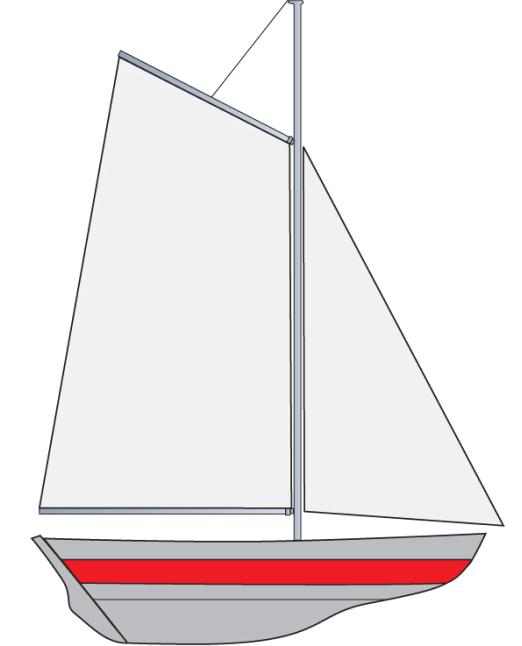
Cons: Not as efficient as the sloop rig, and has more weight aloft.
Junk rig
Fully-battened mainsail favoured by some for short-handed sailing because of its ease of reefing.
Pros: Simple to reef.
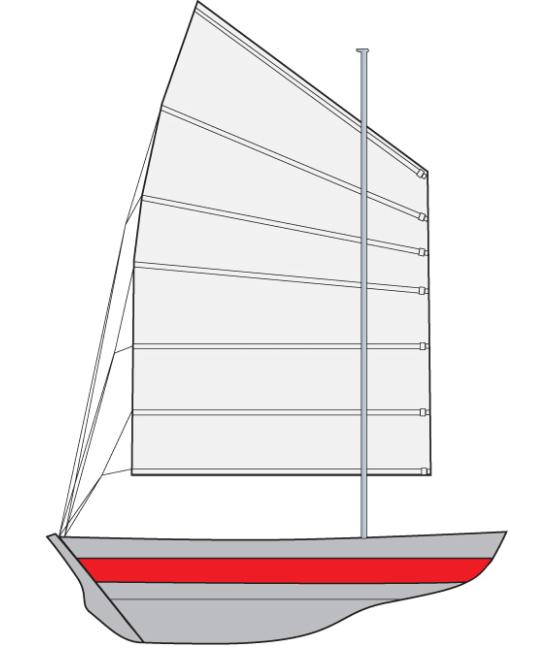
Cons: Not as efficient as a sloop rig.
Ketch rig
Two-masted rig with the mizzen mast set ahead of the rudder post.
Pros: Popular for long distance cruising because the individual sails are smaller and thus easier to handle.
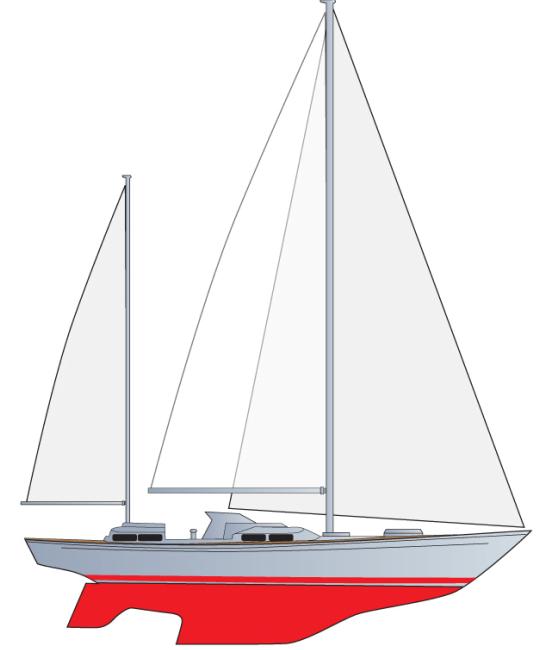
Cons: Greater expense.
Cat/Freedom rig
A simple rig popular in the USA with a large mainsail set on an unstayed mast, close to the bow. The wishbone boom is similar to those used on sailboards.
Pros: Inexpensive and simple to reef.
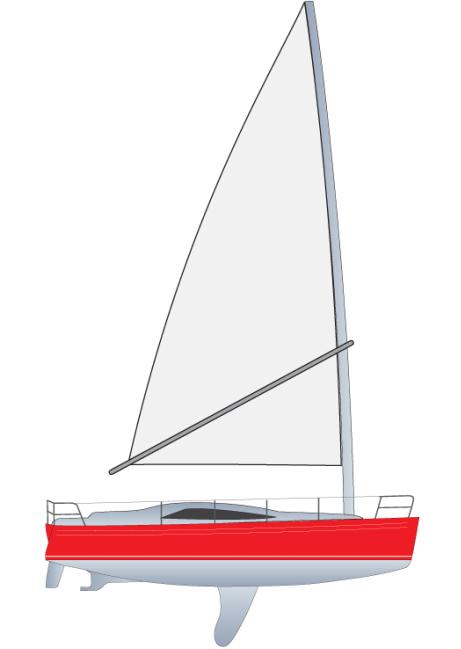
Cons: Not as efficient as a sloop rig.
Yawl rig
Two masted rig with the mizzen mast set behind the rudder.
Pros: The mizzen sail is smaller than on a ketch and thus easier to handle.
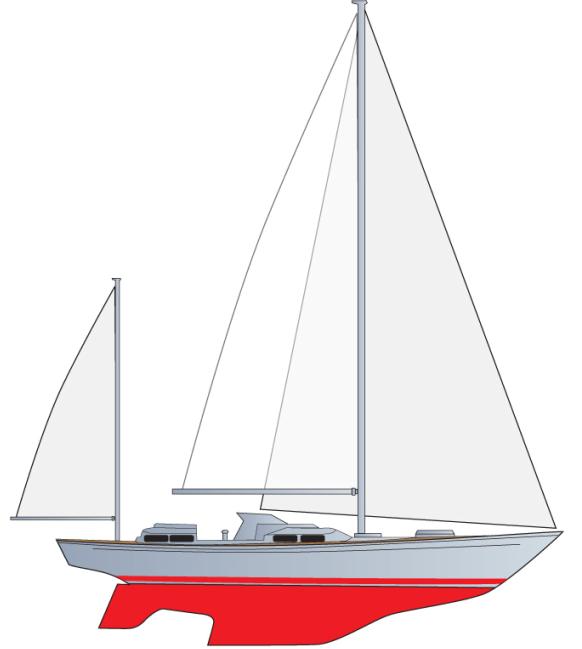
Cons: Like the ketch, greater expense and not as efficient as a fractional rig.
Trailer/sailer
A trailer/sailer is a large dinghy-styled day sailer, or small yacht (with a retractable keel) that can be towed behind the family car. Their advantage lies in being able to explore shallow cruising grounds and be beached safely when the tide recedes.
There is a financial benefit too because they can be stored on their trailer at home rather than in a marina or on a mooring. Most trailer/sailers have the facility to mount Boat Outboard Motorsan outboard motor.
| Drascombe Drifter 22 | ||
|---|---|---|
| Length overall | 22 ft | 6,7 m |
| Waterline length | 19 ft 4 in | 5,9 m |
| Beam | 7 ft 3 in | 2,2 m |
| Draft – keels up | 1 ft 4 in | 0,4 m |
| Draft – keels down | 3 ft 5 in | 1,0 m |
| Displacement | 1,2 tons | |
| Builder | Churchhouse Boats | |
The Drascombe Drifter 22 is the largest in the traditionally lined Drascombe trailer/sailer range. She is equipped with twin drop keels and a lifting rudder to give clear space within the cockpit and cabin, and shallow draft. She has a simple loose footed gunter yawl rig, and the main mast is raised and lowered while the boat is on its trailer, using the trailer winch to take the strain out of the process.
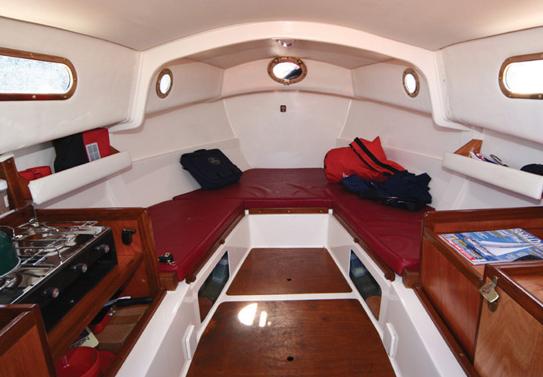
Accommodation includes two single berths that can convert into a double, together with cooking and toilet facilities. An optional cockpit tent offers further accommodation for children.
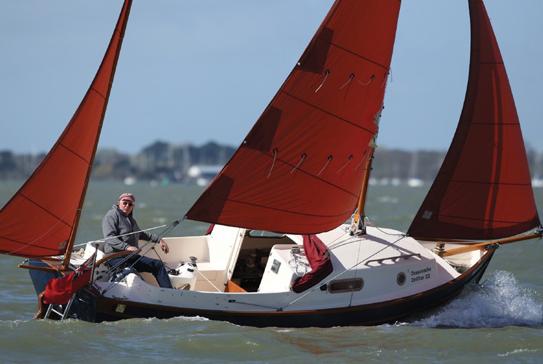
Day sailer
Day sailers, like the 18 ft 9 in (5,7 m) Drascombe Lugger with its traditional gaff rig, mizzen sail and retracting steel centreplate, can be configured for family cruising.
This fibreglass design is easy to launch and recover from a trailer, has a deep cockpit, and their distinctive tan coloured sails are boomless, therefore avoiding possible head injury from a gybing boom.
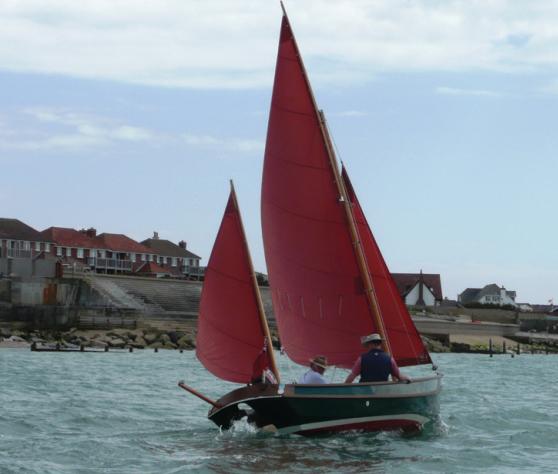
Alternatively, sports boats like the 20 ft 2 in (6,1 m) Laser SB3 with its large sail area and asymmetric spinnaker are not only exciting to sail but offer competitive class racing throughout the world.
This Use of Fiberglass in Boat Constructionfibreglass design has a lifting keel rather like a daggerboard in a dinghy, in order for it to be launched from a slipway, and is lowered and raised once the boat is in deeper water using a removable crane (opposite).
| Laser SB3 | ||
|---|---|---|
| Length overall | 20 ft 4 in | 6,2 m |
| Beam | 6 ft 11 in | 2,1 m |
| Draft – keels up | 9 in | 0,2 m |
| Draft – keels down | 4 ft 10 in | 1,5 m |
| Displacement | 635 kg | |
| Sail area | ||
| Jib/main | 293,8 sq ft | 27,3 sq m |
| Spinnaker | 495 sq ft | 456 sq m |
| Crew | 3-4 | |
| Builder | Laser Performance | |
The boat packs down on to a two-wheel trailer and is light enough to be towed by a family car.
The latest swing-cradle trailers remove the need to immerse the wheels during launching and recovery which extend bearing and brake life considerably.
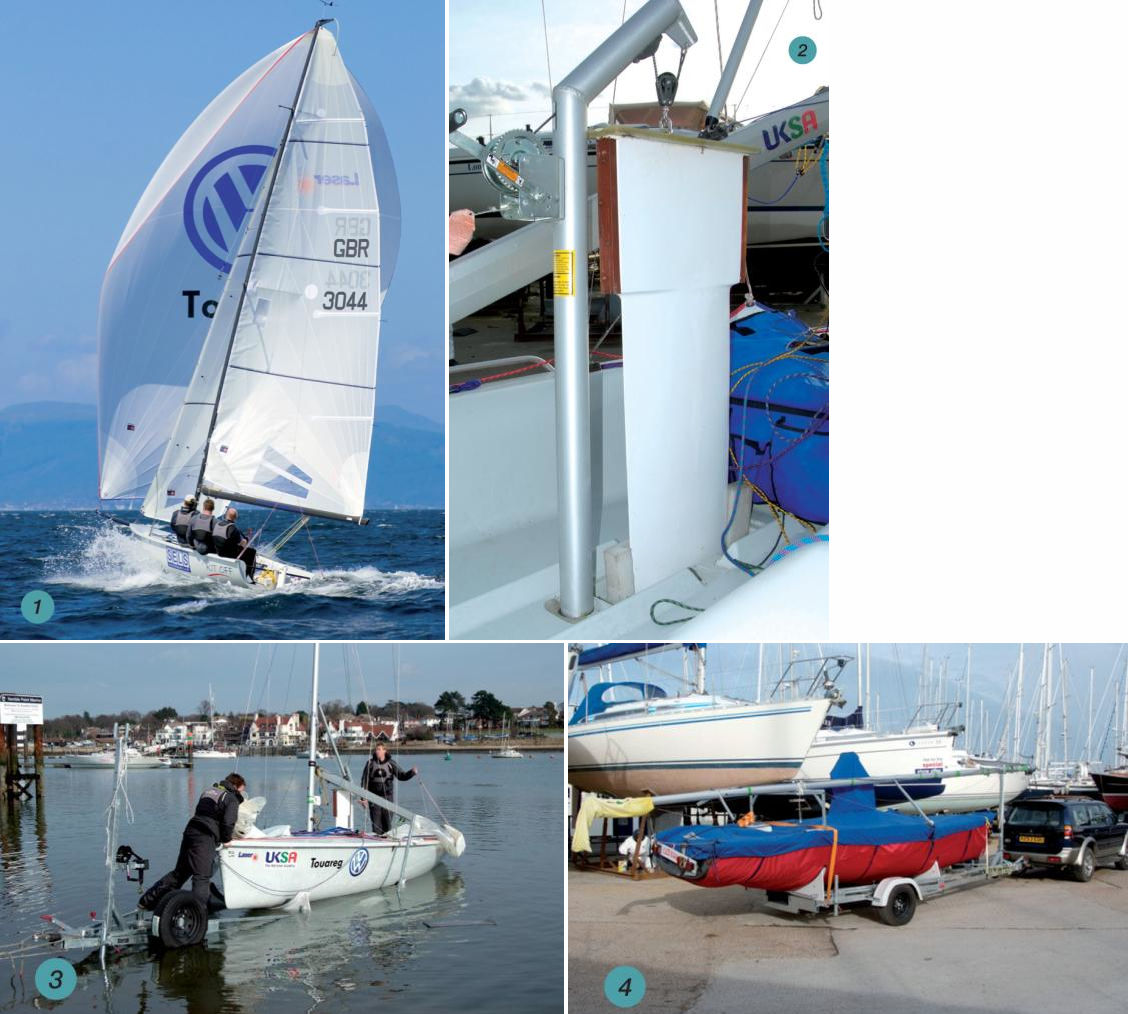
1. Laser SB3 detail; 2. Keel is raised for launching and recovery using this removable crane; 3. Easy to launch – without necessarily getting the trailer wheels wet; 4. Ready to be towed home
Trailer yacht
These are small yachts with fixed or lifting keels designed for cruising and racing on inshore and coastal waters.
Ranging in size from 17-24 ft (5,2-7,3 m) they have a ballast ratio of around 30 % (percentage of keel weight to total weight of yacht) and offer basic accommodation, easy transportation and launching.
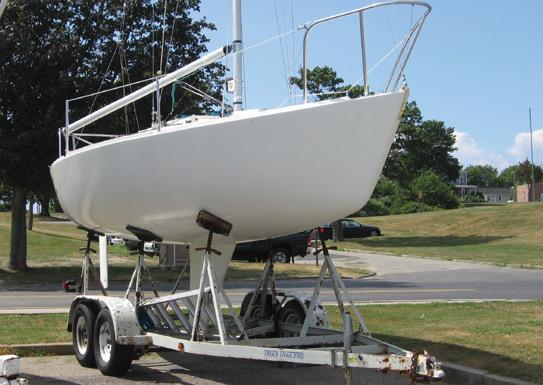
Examples featured in this book include the J24 (7,3 m) (below), the 20 ft 2 in (6,1 m) Beneteau First 20,7, the 21 ft 9 in (6,6 m) Jeanneau Sun 2000, and for the more traditionally minded, the Drascombe Drifter 22 which can accommodate a family of three or four.
Towing
Towing regulations In many countries stipulate that the dry weight of the towing vehicle must, at a minimum, equal the weight of the loaded trailer, which must also be fitted with brakes. Within the European Union, brakes are not required on fully loaded trailers below 750 kg and where the vehicle is at least twice the weight of the tow. From October 2012, all trailers used within the EU must have side as well as tail lights, requiring the car to be wired up with a 13-pin plug rather than the old 7-pin system. Some countries also restrict the driving age to those over 21 and you may be required to pass an additional driving test.
TIP: before buying a boat, check that your vehicle meets the legal restrictions to tow the weight of the boat and its trailer. The car handbook will list the maximum safe towing weight.
Sports boats
Typically 20-30 ft (6-8 m) with a basic cabin, these high performance yachts can still be towed behind a large vehicle, but invariably require a crane to launch and recover them.
Evergreen designs like the 24 ft (7,3 m) J24, carry a traditional spinnaker, but more recent designs like the Melges 24, the 26 ft 3 in (8 m) and J80 are all equipped with masthead asymmetric gennakers flown from the end of retractable bowsprits.
| Melges 24 | |||
|---|---|---|---|
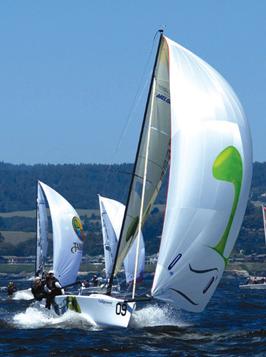 | Length overall | 24 ft | 6,7 m |
| Beam | 8 ft 3 in | 2,2 m | |
| Draft | 5 ft 4 in | 0,4 m | |
| Displacement | 809 kg | ||
| Crew | 4 | ||
| Builder | Melges Performance Sailboats | ||
All are racing oriented sports boats with the emphasis on performance, and have very basic interiors.
| J80 | |||
|---|---|---|---|
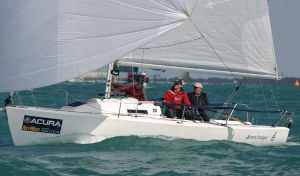 | Length overall | 26 ft | 8 m |
| Waterline length | 2 ft | 6,7 m | |
| Displacement | 1,3 tons | ||
| Crew | 3-5 | ||
| Builder | J Boats | ||
| J24 | |||
|---|---|---|---|
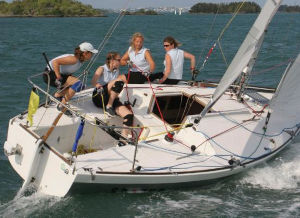 | Length overall | 24 ft | 7,3 m |
| Waterline length | 20 ft 4 in | 6,1 m | |
| Beam | 8 ft 3 in | 2,7 m | |
| Draft | 4 ft 4 in | 1,2 m | |
| Displacement | 1,4 tons | ||
| Builder | J Boats | ||
This popular French trailer/sailer offers hassle-free preparation, easy transportation, good stability and speed, a large comfortable cockpit and creative use of interior space.
| Jeanneau Sun 2000 | |||
|---|---|---|---|
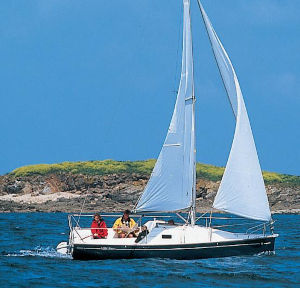 | Length overall | 21 ft 7 in | 6,6 m |
| Waterline length | 20 ft 4 in | 6,1 m | |
| Beam | 8 ft 3 in | 2,5 m | |
| Draft – keel up | 1 ft | 0,3 m | |
| Draft – keel down | 5 ft 2 in | 1,6 m | |
| Displacement | 1,25 tons | ||
| Builder | Jeanneau Yachts | ||
This evergreen trailer/sailer is the baby within the Beneteau range. She is equipped with twin rudders and has recently undergone an interior re-design to provide twin quarter berths and double berth forward.
| Beneteau 21.7 | |||
|---|---|---|---|
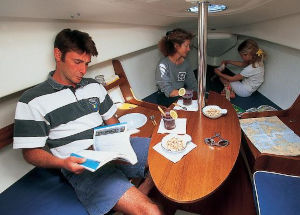 | Length overall | 21 ft | 6,4 m |
| Waterline length | 20 ft 6 in | 6,2 m | |
| Beam | 8 ft 2 in | 2,5 m | |
| Draft – keel up | 2 ft 4 in | 0,7 m | |
| Draft – keel down | 5 ft 10 in | 1,8 m | |
| Displacement | 1,24 tons | ||
| Builder | Beneteau Yachts | ||
Second-hand yachts
Pre-owned yachts offer a very cost-effective entry to sailing. Most are moulded from glass reinforced plastic (GRP) and these have been a popular choice since the first of this kind were built in the late 1960s and 70s. It is quite possible to buy a serviceable second-hand boat for between £4 000 and £10 000.
Compared to the latest offerings, these boats are quite basic in their appearance, especially below decks, so it is a question of finding an example that has benefitted from years of tender loving care. Yachts, especially those from a well-respected builder, hold their value remarkably well and you can expect to recover your initial investment, just as previous owners have done. Westerly was a leading brand both in the UK and America during the 1970s and their boats are ideal examples of production yachts from that era.
See Guidance to buying second-hand (page 72****). 398 of these popular 22 ft (6,7 m) fin-keeled Westerly Cirrus yachts were built between 1968 and 1972. The design packed in two berths forward, a quarter berth under the port cockpit seat, a small dinette on the starboard side that folds down into another berth, opposite the galley area. There is also a separate toilet compartment squeezed in between the forward and main cabins. The John Butler design carries 233 sq ft (21,6 sq m) of sail on a fractional rig, together with optional spinnaker measuring 112 sq ft (10,51 sq m). She is also fitted with Advantages of the Inboard Enginesan inboard engine.
The Westerly Cirrus, a trend-setting pocket cruiser developed in the late 1960s that still provides excellent value on the second-hand market.
| Westley Cirrus | |||
|---|---|---|---|
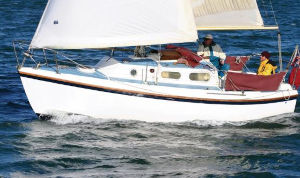 | Length overall | 22 ft | 6,7 m |
| Waterline length | 19 ft | 5,8 m | |
| Beam | 8 ft 2 in | 2,5 m | |
| Draft – keel up | 3 ft 5 in | 1,0 m | |
| Displacement | 3,24 tons | ||
| Builder | Westley Marine Construction Limited | ||
The Westerly Centaur is one of the most popular British built yachts, with some 2 500 launched between 1969 and 1984. A centre-cockpit version was also produced called the Chieftain. While most were sold with a sloop rig, a few yachts were equipped with ketch rigs.
| Westley Centaur | |||
|---|---|---|---|
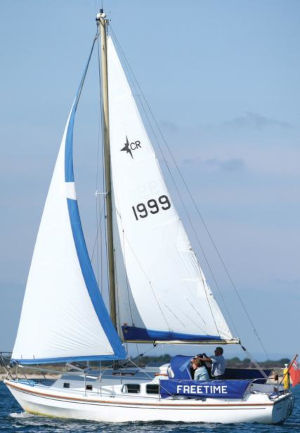 | Length overall | 26 ft | 7,9 m |
| Waterline length | 21 ft | 6,5 m | |
| Beam | 8 ft 5 in | 2,6 m | |
| Draft | 3 ft | 0,9 m | |
| Displacement | 3 tons | ||
| Builder | Westley Marine Construction Limited | ||
She was one of the first mass-produced yachts to have her underwater shape developed in a test tank, which explains why this bilge keeler sails so well. The Centaur was fitted out with either a five or six berth layout and had a Volvo inboard engine.
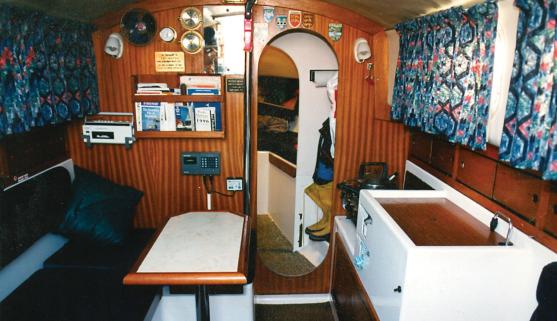
Pocket cruiser racing yachts
Typically 20-26 ft (6,1-8 m) with a cabin and either lifting, fixed or bilge keels, these small yachts can still be towed behind a large car, but invariably require a crane to launch and recover them.
| Beneteau First 25,7 | |||
|---|---|---|---|
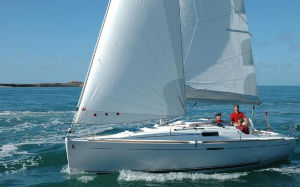 | Length overall | 25 ft 11 in | 7,9 m |
| Waterline length | 24 ft 7 in | 7,5 m | |
| Beam | 9 ft | 2,7 m | |
| Draft – keel up | 2 ft 9 in | 0,8 m | |
| Draft – keel down | 6 ft 1 in | 1,9 m | |
| Displacement | 2,1 tons | ||
| Builder | Beneteau Yachts | ||
Other small yachts like the 25 ft 11 in (7,9 m) Beneteau First 25,7 featured here, are more cruiser/racer orientated with better headroom and a full interior that includes a galley, table, head (toilet) and navigation table, together with 4-5 berths counting the seating in the main cabin.
Mid-sized cruising yachts 27-50 ft (8,3-15,2 m)
27 ft (8,3 m) is by most reckoning, the minimum practical size of yacht for extended cruising and sailing abroad, though of course there are instances where hardy people have crossed oceans in smaller.
The smallest to date is the 5 ft 4 i (1,6 m) Father’s Day in which American Hugo Vihlen sailed from Newfoundland to England in 1993 but you can bet creature comforts were rather less than in a prisoner of war camp sweat box!
| Hunter Channel 31 | |||
|---|---|---|---|
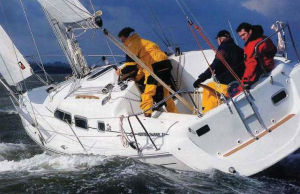 | Length overall | 30 ft 10 in | 9,4 m |
| Waterline length | 26 ft 10 in | 8,2 m | |
| Beam | 10 ft 6 in | 3,2 m | |
| Draft – Standard keel | 5 ft 2 in | 1,6 m | |
| Twin bilge keels | 4 ft 2 in | 1,3 m | |
| Displacement | 4,3 tons | ||
| Builder | British Hunter Yachts | ||
There is an old saying that yacht length (in ft) should measure the same as your age. The longer the boat, the smoother the ride, so when you turn 50, you should be looking at a 50 footer (15,2 m) yacht. Bank balances don’t always allow for that, but if you are planning to do extended cruising, don’t just think about the number of berths, but the stowage space and recreational area available. For anything more than a weekend, a 27 ft (8,3 m) yacht becomes pretty cramped with more than two on board.
32-38 ft (9,7-11,6 m) is the comfortable optimum for 4 people sleeping at opposite ends of the boat while sharing the communal area amidships, and 46-50 ft (14-15,2 m) is really what is needed for six people to live in harmony for any length of time. If your sailing adventures are going to be limited to coastal cruising with overnight stops, then you can fill every berth on board.
| Hallberg-Rassy 310 | |||
|---|---|---|---|
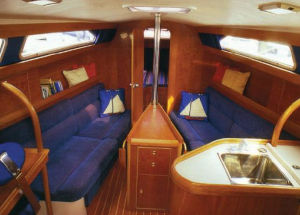 | Length overall | 30 ft 11 in | 9,4 m |
| Waterline length | 28 ft 11 in | 8,8 m | |
| Beam | 10 ft 6 in | 3,2 m | |
| Draft | 5 ft 11 in | 1,8 m | |
| Displacement | 4,35 tons | ||
| Builder | Hallberg-Rassy | ||
Kids in particular love a scrum and all will happily nest away in the smallest of spaces playing games or watching videos. And, providing adults can look forward to getting ashore to a shower block, they will be happy too.
The Hunter Channel 31, like others within the Hunter range, is available with either fin or twin bilge keel options. Her 3-cabin layout provides 6 berths, a well appointed galley and large heads. Her inset transom allows easy access onboard from a dinghy and doubles as a swim platform.
Read also: Anatomy of a Boat Cost and Recommendations for a Profitable Sale
This yacht has a self-tacking jib and all lines lead back to the cockpit. Like other Hunter yachts, the Channel 31 is available fully fitted or as bare mouldings ready for home completion.
The Hunter Channel 31 offers a lively performance and her bright and airy 3-cabin layout, incorporating a double berth under the cockpit, sleeps six in some comfort.
The Hallberg-Rassy 310 is the latest in a long line of introductory designs to this famous Swedish range of yachts. More than 2 000 have been built over the years, and this latest Germán Frers design incorporates the very best elements from this experience.
The new model is wider than her predecessor giving greater room below, and with her short overlap jib and push button winches and furling gear, she is easy to sail with just one or two people. A Code Zero or gennaker can be flown between the masthead and a removable bowsprit. She also carries the trademark Hallberg-Rassy windscreen, integrated rubbing strake and a lead keel.
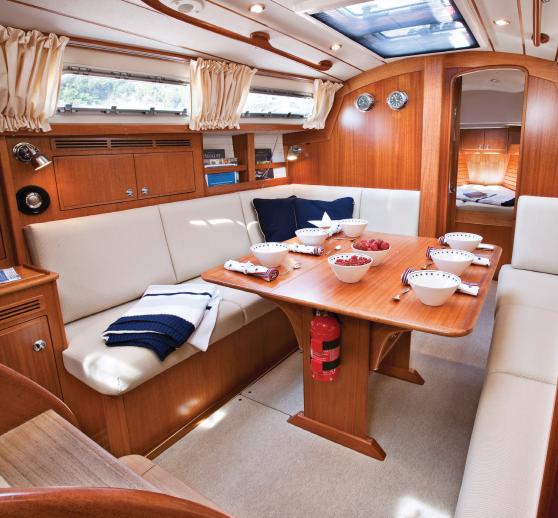
The interior is bright and roomy for her size, with four opening skylights and nine port lights providing light and ventilation. The 2 m L-shape sofa and the straight settee convert into berths. The galley is set to one side away from the main thoroughfare and is fitted with double sinks and a fridge with a basket to organise small items. The counter top is solid PlexiCor composite stone.
The generous sized cabins fore and aft have double berths, and plenty of stowage space. The aft cabin also has vanity and hanging locker. The toilet compartment is well ventilated and the counter top and sink match the kitchen work top.
| Jeanneau Sunfast 3200 | |||
|---|---|---|---|
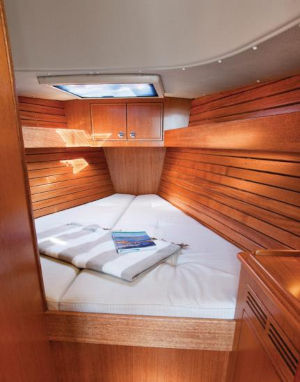 | Length overall | 31 ft 1 in | 10,1 m |
| Waterline length | 28 ft | 8,5 m | |
| Beam | 11 ft 5 in | 3,5 m | |
| Draft | 6 ft 2 in | 1,9 m | |
| Displacement | 3,4 tons | ||
| Builder | Jeanneau Yachts | ||
The 310 is very close winded (33°) and will clip along at 11 knots+ with gennaker set on a broad reach in 20 knots of wind. She is powered by a 22 hp diesel engine and has a tank range of almost 400 miles.
This Jeanneau built one-design class racer/cruiser design was named European Yacht of the Year in 2008 and is moulded using an automated vacuum infusion process to ensure very tight weight and shape tolerances. The yacht has a high level of equipment as standard, a Yanmar 15 hp diesel inboard engine and a well furnished interior. The class offers close one-design racing, but the design also has a competitive rating for handicap racing.
| Beneteau First 30 | |||
|---|---|---|---|
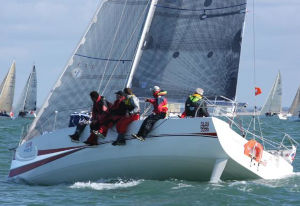 | Length overall | 32 ft 2 in | 9,8 m |
| Waterline length | 31 ft 3 in | 9,5 m | |
| Beam | 10 ft 6 in | 3,2 m | |
| Draft – Shoal keel | 5 ft 1 in | 1,5 m | |
| Standard keel | 6 ft 3 in | 1,9 m | |
| Displacement | 3,4 tons | ||
| Builder | Jeanneau Yachts | ||
The Sunfast 3200 is a low tolerence one-design with a favourable rating for handicap racing.
The First 30 combines performance with a high level of comfort below. The 3-cabin layout provides double berths forward and beneath the cockpit, together with a large communal cabin amidships with galley and nav station. There is a separate toilet compartment opposite the aft cabin.
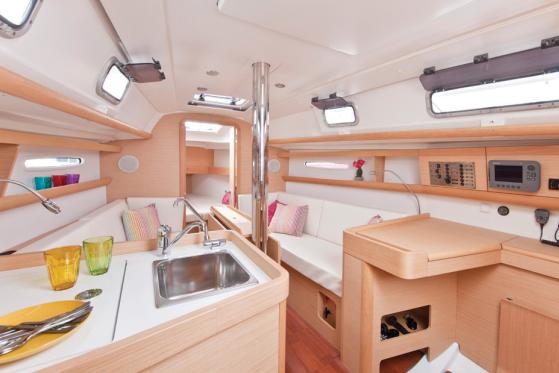
The design has a slender T-shaped bulb keel to provide a low centre of gravity and the rig is supported by swept-back spreaders to avoid the necessity for a back stay.
The Sun Odyssey 379 is a performance cruiser with a difference, offering not just push-button sailing but joy-stick manoeuvring under power. The French design is one of the first to take advantage of the ZF 360° pivoting sail drive, which takes all the pain out of berthing in a tight spot.
| Jeanneau Sun Odyssey 379 | |||
|---|---|---|---|
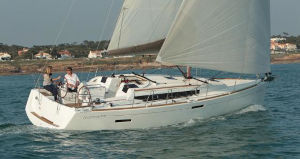 | Length overall | 37 ft 7 in | 11,4 m |
| Waterline length | 36 ft | 11,0 m | |
| Beam | 12 ft | 3,8 m | |
| Draft | 5 ft | 1,5 m | |
| Displacement | 6,7 tons | ||
| Builder | Jeanneau Yachts | ||
The joystick transmits the commands to a control box, which uses the autopilot to lock the helm. Then, a simple movement of the joystick controls the orientation and the thrust of the pod, as well as the bow thruster to move the boat backwards, forwards or sideways.
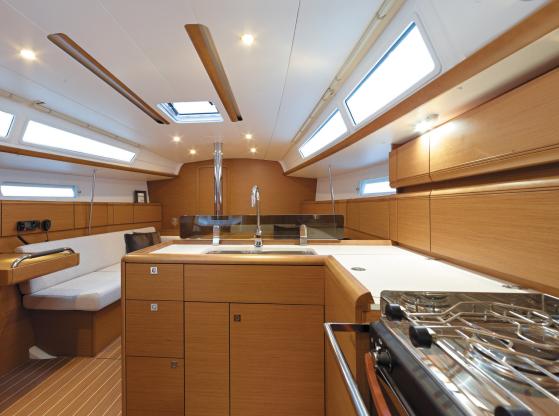
The interior design marries solid wood, stainless steel and light fabrics to provide a warm feeling. The galley has numerous storage compartments, a high-capacity fridge, and there is large saloon table, a hanging locker in the saloon and easy conversion of seating areas to berths.
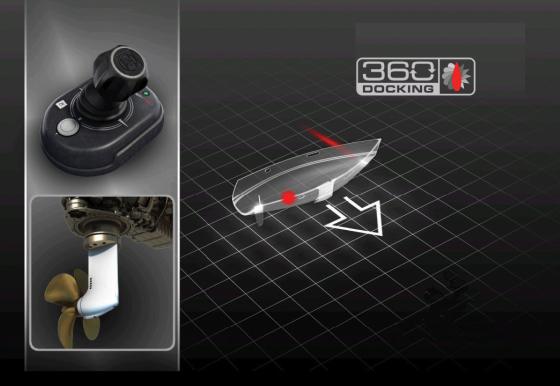
The design is also available with three keel options, a standard wing keel, a shoal keel and a swing keel which varies draft between 3 ft 7 in and 7 ft 4 in (11-2,2 m).
| Southerly 42 RST | |||
|---|---|---|---|
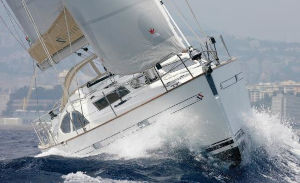 | Length overall | 42 ft 2 in | 12,9 m |
| Waterline length | 36 ft 5 in | 11,1 m | |
| Beam | 13 ft 3 in | 4,0 m | |
| Draft – keel up | 2 ft 9 in | 0,8 m | |
| Draft – keel down | 8 ft 11 in | 2,7 m | |
| Displacement | 11,2 tons | ||
| Builder | Northshore Yachts | ||
The Southerly 42 RST combines a fast, modern hull for good performance, with stability and comfort for blue water cruising. The modern plumb stem maximises waterline length and her broad transom provides volume aft, for performance and interior space.
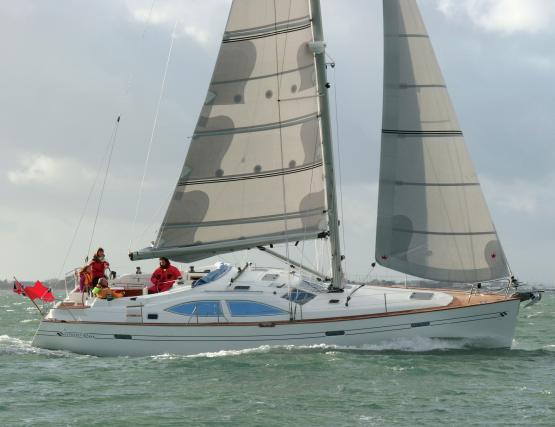
Deck styling and a sociable cockpit layout with twin helm positions, makes this a comfortable and easy to sail blue water cruising yacht.
All Southerly yachts are equipped with an hydraulic swing keel (see page 16***) which has the versatility of having a deep aerofoil-shaped keel for performance, the ability to navigate in very shallow waters and take to the ground safely.
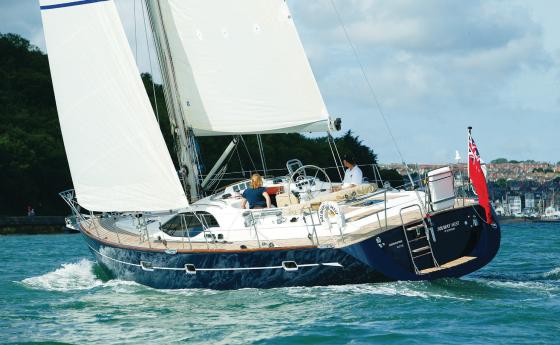
Below decks, the large raised saloon seating area with its all-round views, provides a focal point for comfortable dining whilst at anchor, and the swing keel mechanism remains unobtrusive, hidden within the dinette seating. The well equipped galley and nav station are both positioned to starboard of the central companionway.
| Oyster 46 | |||
|---|---|---|---|
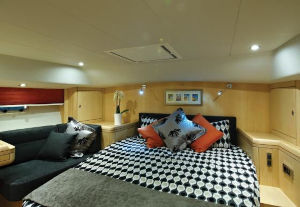 | Length overall | 46 ft 10 in | 14,3 m |
| Waterline length | 40 ft 7 in | 12,4 m | |
| Beam | 14 ft 6 in | 4,4 m | |
| Draft – Standard keel | 7 ft 1 in | 2,2 m | |
| Draft – Shoal keel | 5 ft 9 in | 1,8 m | |
| Displacement | 7,2 tons | ||
| Builder | Oyster Marine | ||
A two cabin layout is standard with a large double aft cabin, enjoying a centreline berth and en-suite facilities. A three cabin layout is also available. The Southerly has a self tacking jib on a roller furler and all leads and sheets run “unseen” through deck conduit back to the cockpit to provide simple push-button control.
The Oyster 46 is a true ocean-going cruiser/racing yacht with a large, sheltered centre cockpit. She has good headroom throughout her 3-cabin accommodation layout, which allows six to sleep in comfort, without using the saloon. The owner enjoys en-suite facilities, whilst the forward two cabins share a comfortable heads and shower.
| Beneteau Oceanis 50 | |||
|---|---|---|---|
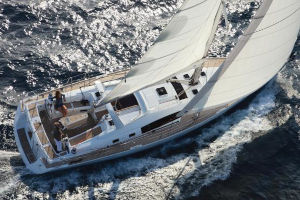 | Length overall | 49 ft 6 in | 15,1 m |
| Waterline length | 48 ft 5 in | 14,8 m | |
| Beam | 14 ft 9 in | 4,5 m | |
| Draft – Standard keel | 6 ft 10 in | 2,1 m | |
| Draft – Shoal keel | 5 ft 9 in | 1,8 m | |
| Displacement | 12,24 tons | ||
| Builder | Beneteau Yachts | ||
This is the smallest in the Oyster range which progresses up to their 125 ft (38,1 m) flagship. The 46 is available with either a standard fin or shoal draft keel and standard alloy cruising rig or lightweight carbon fibre spars.
The Oceanis 50 is available with the option of three or four cabin layouts either with the master suite forward to minimise disturbance when moored stern-to and two double cabins beneath the cockpit, or set aft to provide two really spacious double cabins with en-suite facilities.
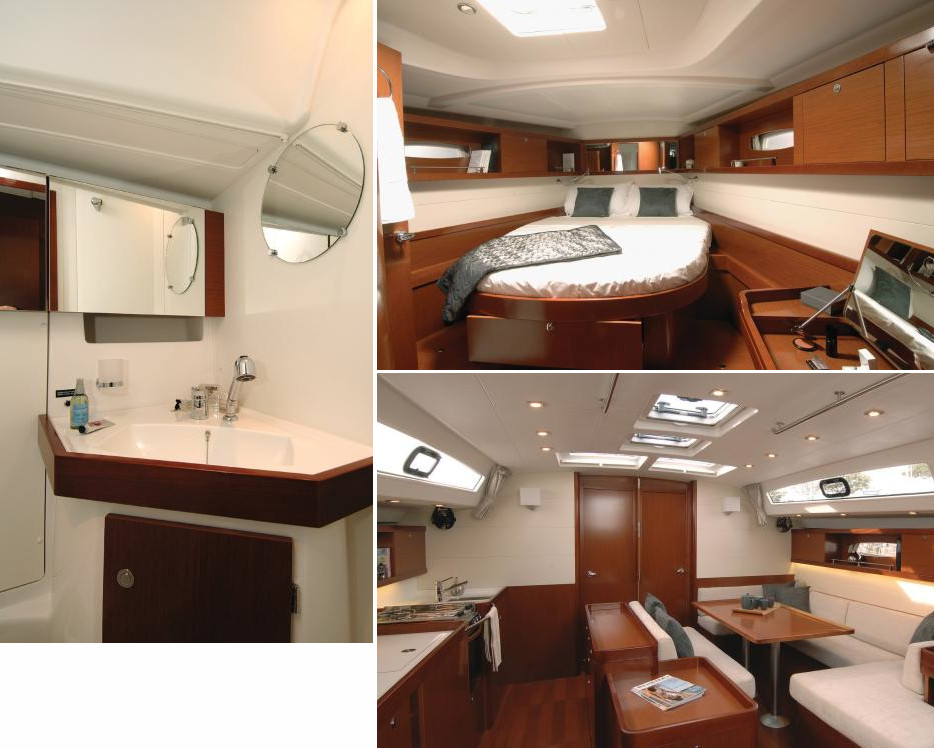
By converting the dinette and utilising the settee in the saloon, it is possible to sleep 13 onboard. She is finished to a very high specification and was voted “Yacht of the Year” in the under 100 ft (30,4 m) category when launched in 2007.
| Bavaria Cruiser 50 | |||
|---|---|---|---|
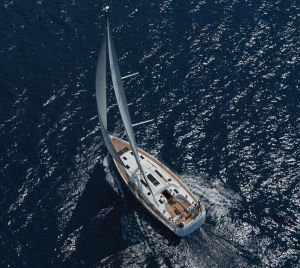 | Length overall | 51 ft 1 in | 15,6 m |
| Waterline length | 45 ft 6 in | 13,9 m | |
| Beam | 15 ft 5 in | 4,7 m | |
| Draft – Standard keel | 7 ft 4 in | 2,3 m | |
| Draft – Shoal keel | 6 ft 1 in | 1,9 m | |
| Displacement | 14,1 tons | ||
| Builder | Bavaria Yachts | ||
The Bavaria Cruiser 50 is a great example of German precision boatbuilding. Manufactured in one of Europe’s most modern facilities, everything about Bavaria yachts scream form and function. The Cruiser 50 is available in either a 3, 4 or a 5 cabin layout with plenty of light shining through a large array of deck hatches.
Common to all is the owner’s suite in the bow area, furthest away from a noisy dockside. Her 18 ft 7 in (4,7 m) beam makes for a cavernous interior which can be fitted out in a wide variety of woods and fabrics.
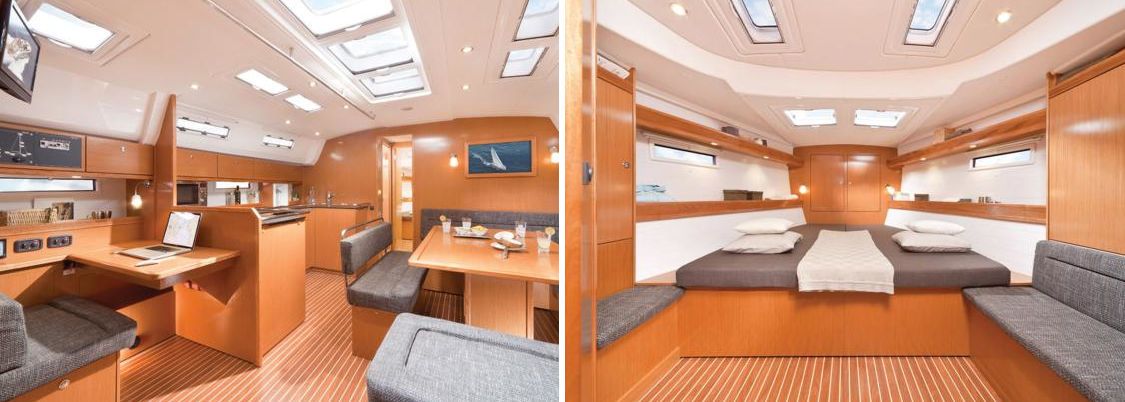
Her large cockpit with its twin wheel steering and dinette table opens up at the transom to provide a large boarding platform.
Multihulls
Cruising multihulls, generally catamarans, have several advantages over monohulls. These include greater speed when sailing off the wind, a large foredeck for sunbathing and far greater volume below decks. This invariably takes the form of a wide communal cabin across the bridge deck coupled with private sleeping quarters, galley and heads within the two hulls.
Their greatest attribute in many eyes, however, is the fact that multihulls don’t heel over like monohulls, but are susceptible to weight limitations. A full compliment of crew and their attendant gear invariably saps their speed advantage.
| Lagoon 400 | |||
|---|---|---|---|
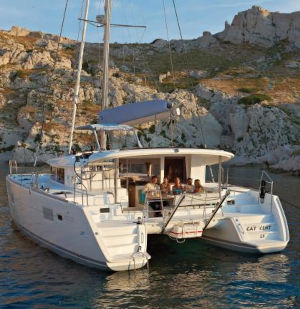 | Length overall | 39 ft 3 in | 12,0 m |
| Waterline length | 23 ft 9 in | 7,2 m | |
| Draft | 4 ft | 1,2 m | |
| Displacement | 10,2 tons | ||
| Sail area | 904 sq ft | 84 sq m | |
| Builder | Bavaria Yachts | ||
Since multihulls rely on their form for stability rather than weighty keels, most are fitted with retractable daggerboards which allows them to be beached safely and sit on a drying mooring. Trimarans (3 hulls) carry more form stability than a twin hulled catamaran, but have less volume below decks.
Onboard the Lagoon 400, the large bridge deck with its panoramic views and sliding glass door opening out to the cockpit, makes this a great social area onboard. The galley is well sited against the cockpit bulkhead to serve both areas. The hulls are devoted to sleeping areas with en-suite facilities. The master suite situated in the starboard hull is accessed via a private dressing room.
The greatest attractions of catamarans are the plentiful sunbathing areas, large alfresco cockpits and bathing platforms at the stern of each hull.
Trimarans
Trimarans offer a better performance than a catamaran, mainly because their form stability allows them to be pushed harder than a cat, without fear of capsize. On the minus side, they have less interior volume, and since they draw very little draft as well, living space within the main hull is invariably smaller to monohulls of equivalent length.
But if performance is a prerequisite, then there is nothing to beat modern trimarans, and designers have even beaten the problems of their extreme beam and the extra mooring fees this incurs at most marinas, by developing folding outriggers that allow boats of 30 ft+ length to be towed on a trailer.
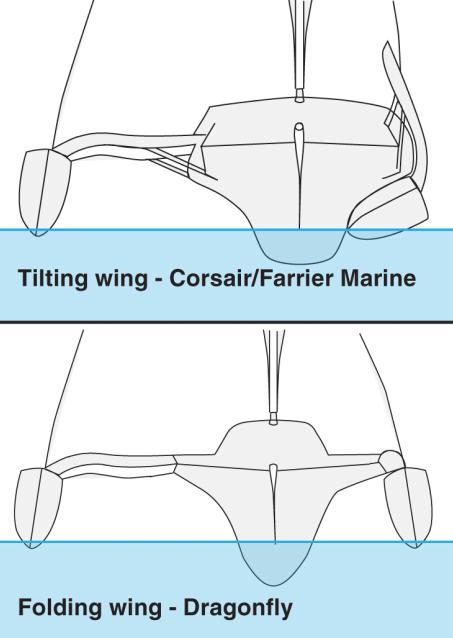
This folding concept has been developed successfully by companies in America, Denmark and New Zealand. Corsair, (now built in Vietnam) and Farrier Marine in New Zealand, share the same vertical tilting wing mechanism that fold the outriggers in on their side. On the Danish built Dragonfly trimarans, the beams are hinged in a horizontal plane and fold in towards the hull in the same attitude as when extended for sailing.
| Sprint 750 | |||
|---|---|---|---|
 | Length overall | 24 ft 4 in | 7,3 m |
| Waterline length | 23 ft 1 in | 7,0 m | |
| Beam – Overall | 18 ft 2 in | 5,5 m | |
| Beam – Folded | 8 ft 2 in | 2,5 m | |
| Draft – Keel Down | 5 ft 5 in | 1,7 m | |
| Draft – Keel up | 1 ft | 0,3 m | |
| Weight | 839 kg | ||
| Builder | Corsair Marine | ||
These trimarans share light displacement (2,69 tonnes in sailing trim for the 24 ft Corsair 750) and shallow draft of less than 1 ft (0,3 m) for even the 38 ft Dragonfly 1200 Ocean Cruiser.
| F-32 | |||
|---|---|---|---|
 | Length overall | 32 ft 3 in | 9,8 m |
| Waterline length | 31 ft | 9,5 m | |
| Beam – Overall | 23 ft | 7,0 m | |
| Beam – Folded | 8 ft 2 in | 2,5 m | |
| Draft – Keel Down | 5 ft 10 in | 1,8 m | |
| Draft – Keel up | 1 ft 5 in | 0,4 m | |
| Weight | 1 270 kg | ||
| Builder | Farrier Marine | ||
They also offer a remarkable performance, able to make 10 knots upwind in little more than 12 knots of breeze, and a scintillating 20 knots+ when sailing off the wind.
| Dragonfly 1200 | |||
|---|---|---|---|
 | Length overall | 39 ft 3 in | 12,0 m |
| Waterline length | 36 ft 9 in | 11,2 m | |
| Beam – Overall | 28 ft 3 in | 8,6 m | |
| Beam – Folded | 14 ft 1 in | 4,3 m | |
| Draft – Keel Down | 6 ft 7 in | 2,0 m | |
| Draft – Keel up | 2 ft 6 in | 0,8 m | |
| Weight | 5 700 kg | ||
| Builder | Quorning Boats | ||
This, the largest of the folding trimaran types, takes up no more space in the marina than similar sized monohulls, yet has seven berths spread between three cabins and can seat eight in her saloon.
Motor sailers
These are at the traditional end of the market, and as their name implies, are half motor, half sailboat. These designs, whose genre can be traced back to early Danish trawler yachts, trade on their study, sea kindly, long keeled hull shape, a powerful engine, well protected deck and aft cockpit, and enclosed wheelhouse. They look safe, they feel safe and they are safe.
Motor sailers are at the heavier end of the displacement scale and none will win races, but given a soldier’s breeze – force 3-5 – they perform well enough under sail.

In lesser winds, or indeed stronger conditions, their powerful engines come into play, and with the mizzen set as a steadying sail, their enclosed environment make them go-anywhere boats.
The most popular are the Fisher range from 30-46 ft (9,1-14 m) now built in the UK by Northshore Yachts, and the Finnish built Nauticat whose models range from 34-44 ft (10,3-13,4 m).
| Fisher 37 | |||
|---|---|---|---|
 | Length overall | 37 ft 2 in | 11,3 m |
| Waterline length | 32 ft 6 in | 9,9 m | |
| Beam | 12 ft | 3,7 m | |
| Displacement | 14,2 tons | ||
| Builder | Northshore Yachts | ||
There are also a large number of self-built models on the secondhand market, some constructed in steel, and others from bare mouldings produced by Colvic Craft for home completion.
| Nauticat 441 | |||
|---|---|---|---|
 | Length overall | 48 ft 6 in | 14,79 m |
| Waterline length | 38 ft 9 in | 11,8 m | |
| Beam | 12 ft 4 in | 3,75 m | |
| Draft | 6 ft 3 in | 1,9 m | |
| Displacement | 16,5 tons | ||
| Builder | Nauticat Yachts | ||
First introduced in 1973, the Fisher 37 is the epitome of a reliable, safe, and sturdy motorsailer. Accommodation is split between a social wheelhouse, main saloon, and double cabins fore and aft.
The Nauticat 441 is another popular 6 berth motorsailer, with a large centre wheelhouse which doubles as a large deck saloon, together with an open bridge deck aft.

